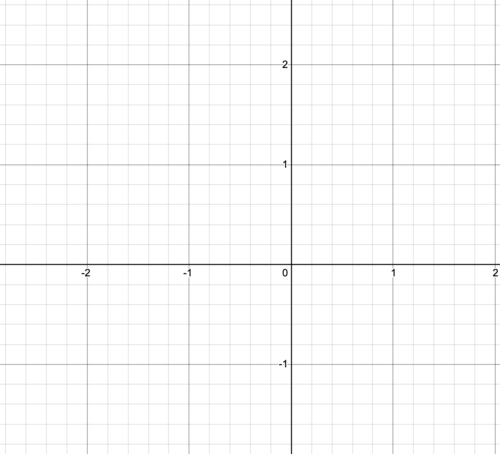域、 共域和范围
章节大纲
-
Given a linear transformation of the form
::给定窗体的直线变换where is a standard matrix
::T(x)=Ax,其中A为标准矩阵The domain of the transformation is the set of all inputs of the variable . So, for example, if is a linear transformation
::变换的域是变量 x 的所有输入的集合。例如,如果 T 是线性变换
::T:RnRmThe set is the input space, or the domain of the linear transformation . So, let's look at an example of a linear transformation and try to find the domain.
::设置 Rn 是输入空间, 或者线性变换 T 的域 。 所以, 让我们看看线性变换的示例, 并试着找到域 。
::T:R3QR3T([x1x2x3]) =[3-120-21-120][x1x2x3]And looking at this transformation we see that the input space has every vector in .
::我们看到输入空间 含有R3中的每一个矢量Now, the codomain of a linear transformation is the space in which the linear transformation maps to.
::现在,线性变换的共域 就是线性变换映射到的空间。So, for example, taking
::例如,举例说,以
::T:R2R3T([x1x2]) =[1-1203-2] [x1x2]Here, we see that the domain of this linear transformation is and the codomain of this matrix is because that is the output space of this linear transformation as the resulting vector will be a vector in .
::在这里,我们可以看到,这种线性变换的域是R2,而这个矩阵的共域是R3,因为这就是这种线性变换的输出空间,因为由此产生的矢量将是R3中的矢量。Now, the codomain of a linear transformation is different than the range of a linear transformation.
::现在,线性变换的共域与线性变换的范围不同。The range of a linear transformation is the set of all of the images of a linear transformation.
::线性变换的范围是线性变换的所有图像的集合。So, staying with the last example we looked at, we have that the codomain is the reals in 3 dimensions. However, the set of all of the images is
::所以,与我们所看到的最后一个例子一样, 我们发现, 共域是3维的真数。 然而, 所有图像的集是
::区域( T) [x1 - x22x13x1 - 2x2] [x1x2] R2}which is a subset of the codomain, however, it is not equal to that.
::这是共域的子集, 但是,它不等于它。Next, let's look at a couple examples and the diagrams of those examples:
::下面,让我们看看几个例子和这些例子的图表:Let
::让 T: R3QR3T( x%) =AxIA = [10- 1230-152] Ax{[10- 1230-152] {[10- 1230-152] {[x1x2x3]The domain of this transformation is all of and the entire output space of this linear transformation is , so the codomain is the same set as the domain which is .
::这种变换的域为R3, 线性变换的整个输出空间为R3, 因此共域与R3的域相同。Now, searching for the set of all images, or in other words, the range, we get that it is equal to
::现在,搜索全部图像集, 换言之, 范围, 我们得到它等于
::区域( T( x) ) [x1 - x32x1+3x2 - 1x1+5x2+2x3] x1,x2,x3}[x1x2x3] [x1x2x3] {R3}Due to technical constraints it will be harder to visualize this linear transformation, but let's try another example and try and apply our principles of domain, codomain and range.
::由于技术限制,很难想象这种线性转变, 但是让我们再试一个例子, 尝试运用我们的域、 共域和范围原则。Now, let
::现在,让我们
::T:R2-R2T(x__)=Ax_A=[52-23]Ax[52-23]和[x1x2]From this, we see that the input and output space, domain and codomain, are both .
::我们从中看到,输入和输出空间, 域和共同域, 既是R2,又是R2。Looking at this to find the range, we get that the range, or the set of all images of the transformations is
::或所有变换图像的集
::{5x1+2x2-2x1+3x2,x1,x2R}Looking at this visually, we see that this linear transformation transforms the space
::我们看到这种直线转换 改变了空间to end up getting
::最终得到
